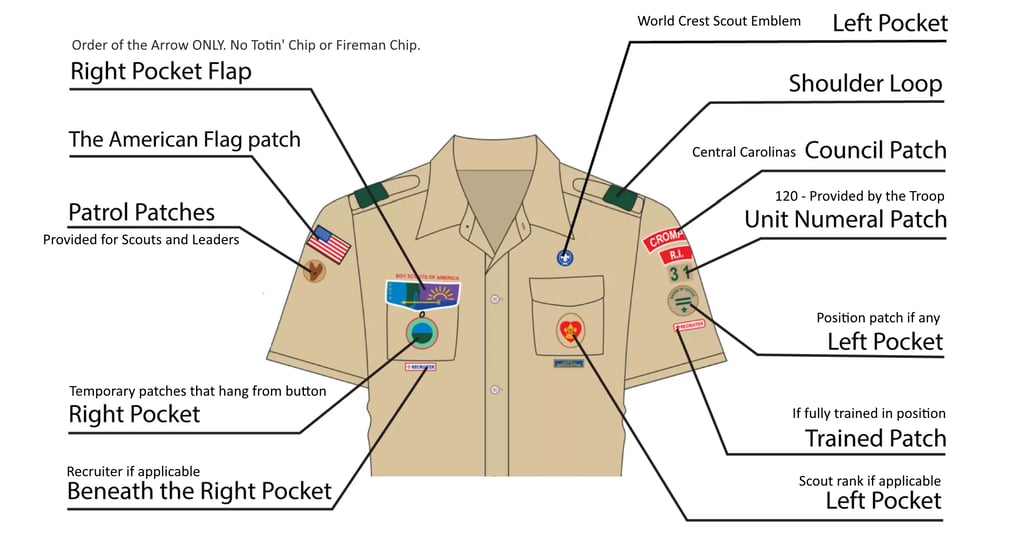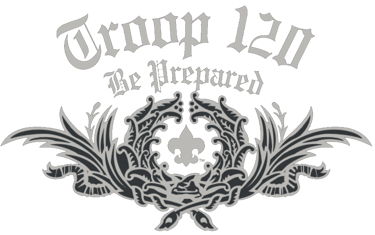Troop 120 Gear Guide!
A guide to what you need for meetings and campouts...
If you are new to Troop 120, one of the most common questions is, "What do I need to get started?" And if a campout is coming up, "What do I need to make sure I have for the campout?" This article attempts to answer both questions.
For meetings:
1. Class A Uniform. Most meetings and events require a formal Class A uniform. You can purchase this at Scoutshop online or at a local Scoutshop store where they will expertly help you. We provide Troop 120 numbers. You need scout shirt, green socks, green pants, green shoulder loops, scout belt, central carolinas patch, these patches, and a merit badge sash (only worn with six merit badges at special ceremonies). Note that you must wear the uniform with closed-toed shoes. We recommend going to a seamstress that knows Scouts, like Amiable Alterations. But you can do it yourself too! For more information on how to construct the shirt, see Scouts Guide to Insignia or review the image below for placement:
2. Scouts BSA Handbook. You need to bring the handbook to every meeting for sign-offs. It's also where you learn Scouting skills needed for advancement. You can order the BSA Handbook here. We also strongly recommend a cover like this one, but you can find others on Amazon or Etsy. And on campouts, use the cloth cover AND a gallon zip lock. Treat your book with care to make it last!
3. Class B T-Shirt. When we do service projects, go on campouts, or have casual meeting nights, we often wear our Class B uniform. This consists of solid-colored neutral shorts or pants and a Class B T-Shirt. You can order a Troop 120 Class B T-Shirt here on our website. But note that there is no shipping. You pick it up by asking a leader to help you get one from the storage closet.
For campouts (car camping):
Most campouts are "car camping", meaning we drive cars and usually the Troop trailer to a campground for the weekend. A few days before the campout, we'll send an email reminding you what you need to bring. Many of those items are common (like your toothbrush or rain coat), and you probably already own them. But there are a few things you probably don't own. Here is some advice:
1. Tent. You don't have to buy a tent! Troop 120 has tents to check out for camping trips. However, if you do want to bring your own tent on a campout, please make sure they are a one-person or two-person tent. We don't have room to take larger tents on trips!
2. Sleeping Bag. Getting a quality sleeping bag is a good investment for Scouts. Consider getting one that is rated for 15 degrees or at most 30. Typically, you'll be most comfortable if the weather is 10 degrees or more warmer than your bag. You can also buy a sleeping bag liner for warmer bags and that helps keep you warmer on cold campouts. REI has a lot of options and a local store with helpful associates. If you invest in a sleeping bag, look for one that compresses to a small size so it can fit in a backpacking pack. Bulky sleeping bags don't work for backpacking trips (although you can bring them for car camping).
3. Sleeping pad and optional pillow. You definitely need a pad to sleep on. There are many different kinds. Most scouts have mats that you blow up by mouth or foot pump. Others take foam mats that are expandable. It's really preference. You can explore many sleeping pad options on Amazon or at REI online or at the REI store in Pineville. Pillows are optional. You could just ball up a sweatshirt and sleep on it as a pillow. However, inflatable pillows are really nice!
4. 32 oz Nalgene Water Bottle. Although you can bring any water bottle, 32oz Nalgene water bottles are light weight and durable, and, more importantly, have enough water on long hikes! Avoid metal water bottles.
5. Mess kit. This is just a fancy way of saying something to eat on and eat with! So in a pinch, you could bring any bowl or plate and any fork or spoon. However, you could also invest in a backpacking mess kit that comes with a pot and pan and utensils. This is very important so you can eat the meals your patrol cooks! Amazon has many different mess kit options.
8. Head lamp. Although you could bring a flashlight, headlamps are more useful. Bring some extra batteries, or, if you have a rechargeable headlamp, bring a small charging brick.
9. Something to put all your stuff in! For car camping, you can put your stuff in a pack or in a plastic tote or whatever it will fit in. We will just be moving our stuff from the cars to the campsite, so it's not problem. You'll also want to own a day-pack. This could just be a drawstring bag or an old backpack. We use those for hikes.
For backpacking (primitive camping):
Once or twice a year, we try to do a backpacking trip. This is where we hike all our gear into a primitive site typically a mile or more into the wilderness. Most of the items above also apply to backpacking. You can wait for a backpacking trip to invest in extra gear for this type of trip. The one main thing you need for this type of trip is:
1. Backpacking pack. Since we are carrying all of our gear to a remote location, you need a backpacking pack that can hold all of your gear with good straps and supports to allow you to carry the extra weight. We highly recommend going to a physical REI store and getting help from the associates and what to buy and how to wear it. This is not an inexpensive item, and you could also look to buy a used pack and get help from your fellow Scouts and Leaders to get help on how to use it. If you are buying a new pack, note that there are youth and adult sizes. There are also different carrying capacities. Youth packs are often 40-55 liters. But older/larger youths and adults should consider bigger packs in the 65-85 liter range (for example, high adventure hiking at Philmont recommends this range).
2. Other gear. There may be other gear for backpacking trips that will be shared in advance of the trip. Dry-bags are key items for keeping your stuff dry if there will be water crossings or canoeing, for example. But 2 gallon zip lock bags could also work. Each backpacking trip will have advance communication about what might be needed.






